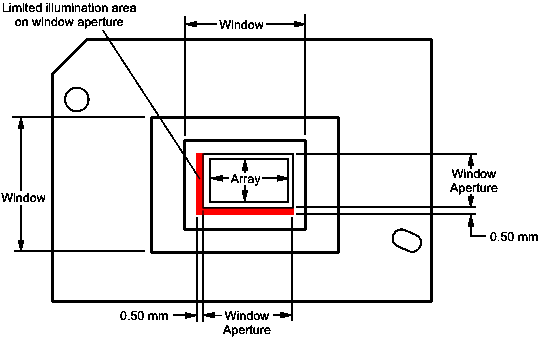JAJSF31B November 2017 – June 2019 DLP3030-Q1
PRODUCTION DATA.
- 1 特長
- 2 アプリケーション
- 3 概要
- 4 改訂履歴
- 5 Pin Configuration and Functions
-
6 Specifications
- 6.1 Absolute Maximum Ratings
- 6.2 Storage Conditions
- 6.3 ESD Ratings
- 6.4 Recommended Operating Conditions
- 6.5 Thermal Information
- 6.6 Electrical Characteristics
- 6.7 Timing Requirements
- 6.8 Switching Characteristics
- 6.9 System Mounting Interface Loads
- 6.10 Physical Characteristics of the Micromirror Array
- 6.11 Optical Characteristics of the Micromirror Array
- 6.12 Window Characteristics
- 6.13 Chipset Component Usage Specification
- 7 Detailed Description
- 8 Application and Implementation
- 9 Power Supply Recommendations
- 10Layout
- 11デバイスおよびドキュメントのサポート
- 12メカニカル、パッケージ、および注文情報
6.4 Recommended Operating Conditions
Over operating free-air temperature range (unless otherwise noted)| MIN | NOM | MAX | UNIT | |||
|---|---|---|---|---|---|---|
| SUPPLY VOLTAGE RANGE | ||||||
| VREF | LVCMOS interface power supply voltage(3) | 1.65 | 1.8 | 1.95 | V | |
| VCC | LVCMOS logic power supply voltage(3) | 2.25 | 2.5 | 2.75 | V | |
| VOFFSET | Mirror electrode and HVCMOS voltage(3) | 8.25 | 8.5 | 8.75 | V | |
| VBIAS | Mirror electrode voltage | 15.5 | 16 | 16.5 | V | |
| |VBIAS – VOFFSET| | Supply voltage delta(2) | 8.75 | V | |||
| VRESET | Mirror electrode voltage | –9.5 | –10 | –10.5 | V | |
| VP VT+ | Positive going threshold voltage | 0.4 × VREF | 0.7 × VREF | V | ||
| VN VT– | Negative going threshold voltage | 0.3 × VREF | 0.6 × VREF | V | ||
| VH ∆VT | Hysteresis voltage (Vp – Vn) | 0.1 × VREF | 0.4 × VREF | V | ||
| IOH_TDO | High level output current @ Voh = 2.25 V, TDO, Vcc = 2.25 V | –2 | mA | |||
| IOL_TDO | Low level output current @ Vol = 0.4 V, TDO, Vcc = 2.25 V | 2 | mA | |||
| TEMPERATURE DIODE | ||||||
| ITEMP_DIODE | Max current source into temperature diode(5) | 120 | µA | |||
| ENVIRONMENTAL | ||||||
| ILLUV(4) | Illumination, wavelength < 395 nm | 0.68 | 2.0 | mW/cm2 | ||
| ILLIR | Illumination, wavelength > 800 nm | 10 | mW/cm2 | |||
| TARRAY | Operating DMD array temperature (monitored by TMP411-Q1 via DLPC120-Q1)(1)(6)(7) | –40 | 105 | °C | ||
| ILLOVERFILL(8) | Illumination overfill maximum allowable heat load on left and bottom sides of the aperture, TARRAY < 75°C(9) | 26 | mW/mm2 | |||
| Illumination overfill maximum allowable heat load on left and bottom sides of the aperture, TARRAY > 75°C(9) | 20 | mW/mm2 | ||||
(1) DMD active array temperature can be calculated as shown in Active Array Temperature section. Additionally, the DMD array temperature is monitored in the system using the TMP411-Q1 and DLPC120-Q1 as shown in the system block diagram.
(2) To prevent excess current, the supply voltage delta |VBIAS – VOFFSET| must be less than or equal to 8.75 V.
(3) VBIAS, VCC, VOFFSET, VREF, VRESET, VSS are required to operate the DMD.
(4) The maximum operation conditions for operating temperature and illumination UV shall not be implemented simultaneously.
(5) Temperature Diode is to allow accurate measurement of the DMD array temperature during operation.
(6) For applications that are higher brightness (> 1000 lumens) or underfill the active array optically, the TMP411-Q1 and temperature sensing diode are not sufficient to determine maximum array temperature. Contact TI Applications Engineering for array temperature calculation methods for this application.
(7) TI assumes a normal automotive operating profile without continuous operation at either minimum or maximum temperatures. Operating profile information for device duty cycle and temperature may be provided if requested.
(9) Heat load outside the aperture in the red areas shown in the figure below should not exceed the values listed in the table. These values assume a uniform distribution. For a non-uniform distribution, please contact TI Applications Engineering for additional information.

